Best Home Telescope To See Planets (2024 Update)
For aspiring astronomers and space enthusiasts, having a quality telescope at home can make a world of difference when it comes to exploring the cosmos. With so many different types and models of telescopes on the market, choosing the right one to meet your needs and expectations takes careful consideration. Before making a purchase, it’s important to understand the key factors that will determine the overall performance and capabilities of a home telescope.
One of the most important considerations is aperture, which refers to the diameter of the telescope’s main mirror or lens. Larger apertures allow for better light gathering power and higher resolution views of celestial objects. For viewing planets in particular, an aperture of at least 4 inches is recommended for noticeable detail, while 8 inches or more is ideal. The mount and tripod are also key, providing stable tracking of objects as they move across the night sky. More advanced mounts with computerized tracking capability provide an even easier observing experience.
Will you be transporting and setting up your telescope often, or keeping it in a permanent observatory setup? The size, weight, and portability are factors to consider here. Do you want the simplicity of a reflector or refractor design, or the wider field views of a Schmidt-Cassegrain telescope? Determining your budget, skill level, and primary goals are also important in narrowing the options.
While buying guides and reviews can provide useful insight, there’s no substitute for directly comparing telescopes in person. By taking the time to properly evaluate all the specifications and features available today, you can find the ideal home telescope to bring the stars and planets to life right before your eyes.
10 Best Home Telescope To See Planets
| # | Product Image | Product Name | Product Notes | Check Price |
|---|---|---|---|---|
|
1
|
It is an ideal portable refractor telescope for beginners that comes with fully-coated glass optics and astronomy software.
|
|
||
|
2
|
Ideal for amateur astronomers who want to observe celestial objects with high precision and clarity.
|
|
||
|
3
|
The product is ideal for astronomical viewing with a clear and high-quality image.
|
|
||
|
4
|
The product is ideal for beginners and kids who are interested in astronomy and want to observe the night sky.
|
|
||
|
5
|
Ideal for amateur astronomers who want to observe planets, stars, and galaxies with a large-aperture telescope on a budget.
|
|
||
|
6
|
This product is ideal for beginners interested in astronomy, with features such as a moon filter and tripod.
|
|
||
|
7
|
Ideal for beginners or amateur astronomers looking to explore the night sky with fully coated glass optics and adjustable tripod.
|
|
||
|
8
|
The product is ideal for kids and beginners who want to explore astronomy and stargazing with a portable telescope.
|
|
||
|
9
|
It is ideal for amateur astronomers looking to view celestial objects such as stars, planets, and deep-sky objects.
|
|
||
|
10
|
Ideal for beginners interested in astronomy, with fully-coated glass optics and an adjustable-height tripod, plus bonus software package.
|
|
1. Travel-Ready Beginner Telescope With Bonus Software
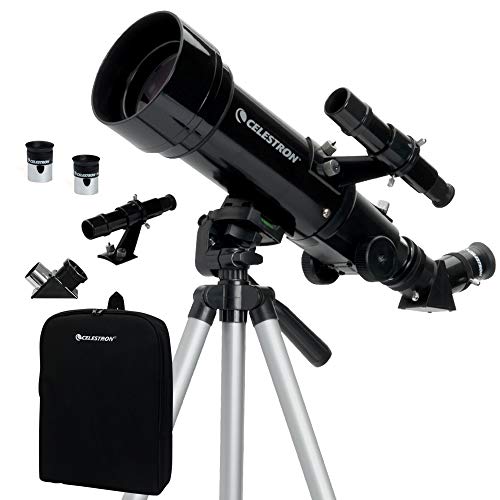
The 70mm Travel Scope offered by Celestron is an exceptional telescope that provides superior optics and a wide range of features that are unmatched by competitors in its class. This telescope is equipped with fully-coated glass optics, a powerful 70mm objective lens, and a full-height tripod that provides stable support for extended observation.
One of the most notable features of this telescope is its powerful eyepieces that allow for up-close viewing of celestial objects at night and land-based objects during the day. The telescope comes with two high-quality eyepieces, a 20mm and a 10mm, that provide low- and high-power views, respectively.
The 70mm objective lens is a key feature that sets this telescope apart from the 50mm model. The larger aperture provides brighter and more detailed views while adding very little additional weight. This makes it easy to transport and set up, even for beginners.
The Travel Scope comes with a bonus backpack that allows you to take it with you wherever you go. The scope and tripod are easy to set up and use, making it perfect for beginners and experienced users alike. You'll also receive a free download of one of the top-rated astronomy software programs.
When you purchase the 70mm Travel Scope from an Authorized Dealer on Amazon, you can buy with confidence knowing that it comes with an unbeatable warranty and support from Celestron. As a leading telescope brand based in California since 1960, you can trust that you are getting a quality product backed by a team of US-based experts. The telescope comes with a 2-year US warranty and unlimited support from the Celestron team.
2. Advanced Vx 6" Refractor
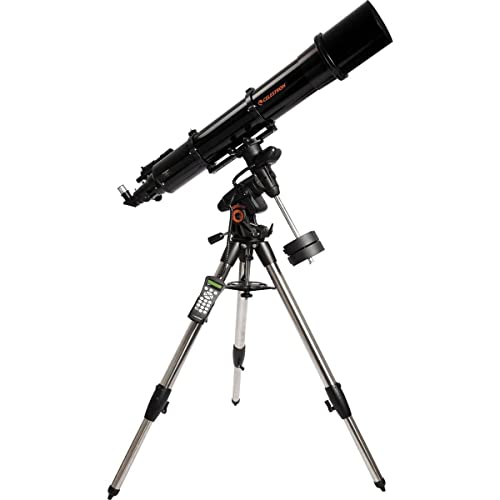
The Celestron Advanced VX 6-inch Refractor Telescope is a top choice for astroimagers seeking the highest contrast for planetary imaging and brighter deep-sky object viewing. This optical tube boasts advanced features such as an integrated telescope support, alignment, and guiding system, and a computerized GoTo mount for optimum performance with smaller telescopes.
The improved motors of the Advanced VX mount provide greater torque and can handle slight load imbalances with ease, ensuring smooth and precise tracking. The updated industrial design of the telescope offers improved rigidity, less flexure, and enhanced aesthetics. Additionally, the new design allows for unobstructed viewing or imaging across the meridian without interference from the motor housings.
One of the standout features of the Celestron Advanced VX 6-inch Refractor Telescope is its SkyAlign function. This function makes computerized aligning of the telescope fast, easy, and accurate. With just three bright objects pointed out in the sky, the telescope aligns itself seamlessly, impressing both observers and astroimagers alike.
3. Explore Scientific 102mm F/7 Air-Spaced Triplet Ed Apochromatic Refractor
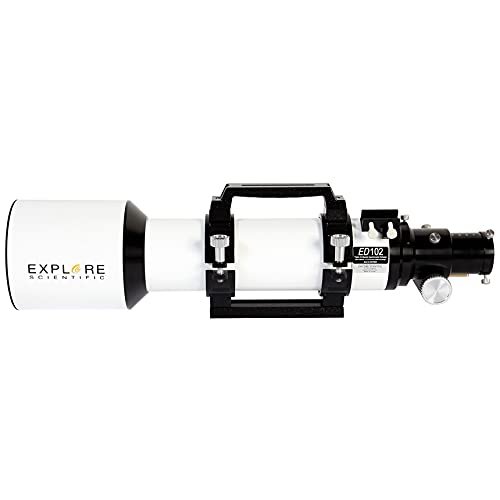
The telescope's focal length measures 714mm, while its focal ratio is f/7, which ensures clear and detailed images. With a magnitude of 12.5, it can capture celestial objects that are faint to the human eye. Additionally, the telescope's resolution is 1.14 arcsec, which means it can capture fine details of celestial bodies with remarkable clarity. These specifications make it an ideal tool for both amateur and professional astronomers who want to explore and study the night sky. Whether you're looking to observe deep-sky objects or planets in our solar system, this telescope is equipped to deliver exceptional results. Its high-quality optics and precision engineering make it a reliable and efficient instrument for stargazing enthusiasts who want to take their hobby to the next level. With its powerful magnification and impressive resolution, you can expect to see breathtaking views of the cosmos that will leave you in awe.
4. Astronomy Starter Kit For All Ages
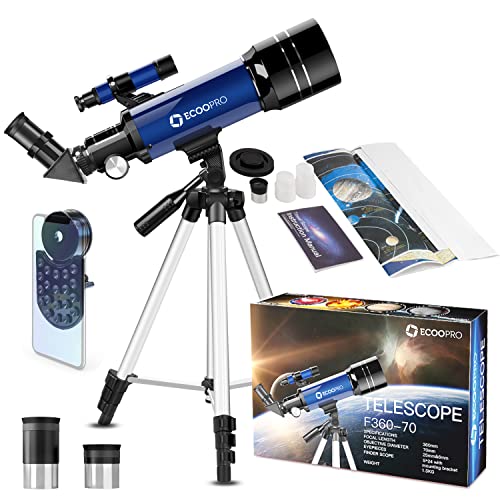
The telescope being reviewed here is a fantastic tool for anyone looking to explore the night sky or observe wildlife and scenery during the day. With a focal length of 360mm and an aperture of 70mm, this telescope is designed to provide crisp, clear images with enhanced brightness and clarity.
One of the standout features of this telescope is its fully coated optical glass with high transmission coatings, which ensures that the images you see are of the highest quality possible. Additionally, the telescope comes with two 1.25" eyepieces (K25mm & K10mm), allowing you to enjoy magnification ranging from 51X to 128X. The included 5X24 Finder Scope also makes it easy to locate objects quickly.
Setting up the telescope is incredibly easy, thanks to the no-tools quick setup design. This makes it a perfect option for kids and astronomy beginners, and it makes for a great gift option for children. The adjustable tripod allows you to view objects from any position, making it ideal for use during the day or at night.
One of the standout features of this telescope is its versatility. While it excels at nighttime observing of the moon and stars, it's also great for daytime birding and observing wildlife and scenery. This makes it a great option for anyone who wants to get up close and personal with the world around them.
5. Celestron – Powerseeker 127eq
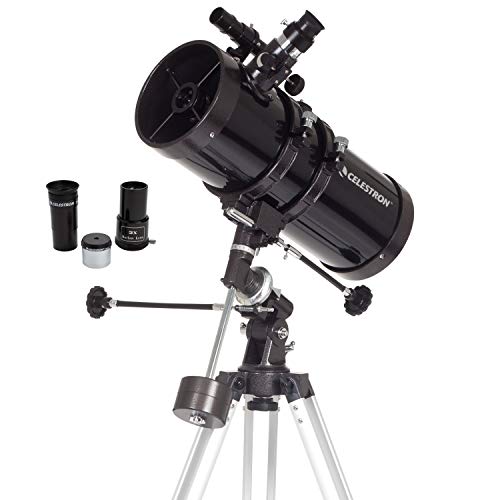
The Celestron PowerSeeker 127EQ is an exceptional telescope that is ideal for both beginners and experienced stargazers. This telescope boasts a 127mm Newtonian Reflector, which provides powerful light gathering abilities that make it possible to observe celestial objects such as the Moon's craters, planets, distant stars, and the Orion Nebula.
Navigating the sky is made possible by the manual German Equatorial mount, which comes with a slow-motion altitude rod. This mount allows users to effortlessly locate celestial objects and accurately follow them as they appear to move across the night sky.
In terms of portability, the Celestron PowerSeeker 127EQ is compact, lightweight, and easy to carry around, making it an ideal choice for both indoor and outdoor use. Whether you prefer taking it to your favorite campsite, a dark sky observing site or simply observing from your backyard, this telescope is a great fit.
The Celestron PowerSeeker 127EQ also comes with multiple accessories that guarantee a great observing experience. These include two quality eyepieces that measure 20mm and 4mm, plus a 3x Barlow lens that can triple the power of each eyepiece. Furthermore, users receive a free download of one of the top-rated astronomy software programs.
As a leading telescope brand in California since 1960, Celestron provides unbeatable warranty and support to its customers. Upon purchase, users receive a 2-Year US Warranty, as well as unlimited support from the brand's team of US-based experts.
6. Astroscope: 80mm Travel Telescope For Beginners
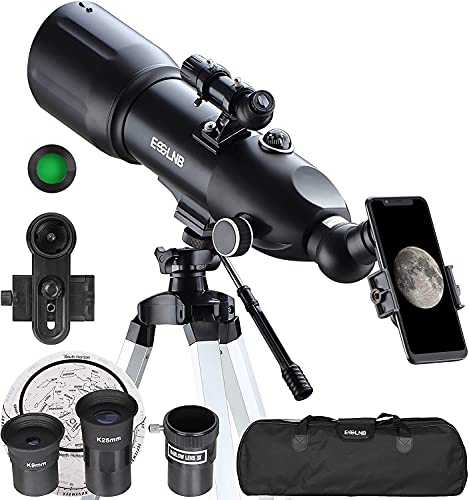
Introducing the High-Transmission Optical Lens Telescope, a must-have for astronomy novices, children, and adults. This telescope boasts a 400mm focal length and a big objective lens, along with multi-fully high transmission coated all-optical lens, that significantly enhances image brightness and clarity. It also has an 80mm objective diameter, providing a broad field of view and a comfortable viewing experience.
The adult telescope features 1.25" high power interchangeable eyepieces with the latest generation of Kellner eyepieces (K9mm, K25mm), and a 3X Barlow lens that magnifies the image three times. For added protection, the eyepieces and Barlow lens are stored separately in a tiny accessory bag. It also comes with a metal moon filter that helps shield your eyes from glare.
This telescope produces erect images and a comprehensive viewing angle, thanks to the 128° Erect-image diagonal prism and the 5X20 Erect-image finder scope. The 128° diagonal prism can rotate 360°, providing more comfortable and liberated observation than other inverted diagonals. Additionally, the telescope phone adapter with a 10X eyepiece allows for easy installation and video or picture capture.
For optimal viewing positions in various locations, the aluminum tripod can be adjusted by 180 degrees in the vertical direction and 360 degrees in the horizontal direction. The novice telescope's height may be adjusted to 120cm, and it comes with a backpack that makes it easy to transport.
The package includes a telescopios astronomic, a K25mm eyepiece, a K9mm eyepiece, a 3X Barlow lens, a protective cover, an adjustable tripod (Tray included), a finder scope, a phone adapter with a 10X eyepiece, a star target planisphere (PVC), a metal moon filter, a backpack, an accessory backpack, a cleaning cloth, and a user manual. The phone adapter already has a 10X eyepiece, so you need not use it along with K9/25mm.
7. Astromaster 70az Telescope Bundle: Optics & Software.
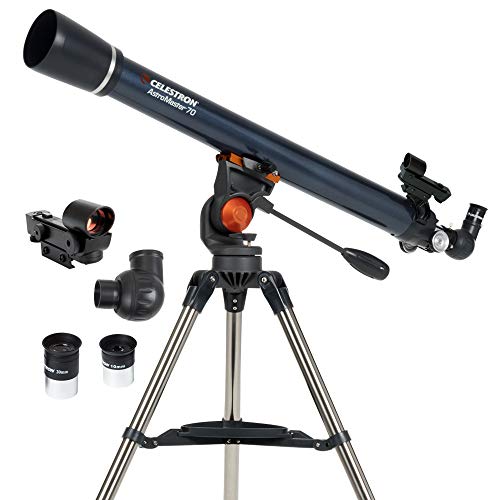
The Celestron AstroMaster 70AZ Refractor Telescope is an exceptional tool for astronomy enthusiasts. This telescope boasts of fully coated glass optics, a full-height tripod, 2 eyepieces, and a red dot finderscope. It is built to be powerful and user-friendly, making it an excellent choice for both beginners and experienced stargazers.
The high-quality 70mm optics of this Celestron telescope make it possible to observe celestial objects at night and land-based targets like wildlife and landscapes during the day. With its sturdy-yet-lightweight frame and a panning handle with Alt-Az control, users can smoothly and accurately point the telescope in any direction. Setting up the telescope is also a breeze, and no tools are required.
To enhance your stargazing experience, Celestron has included 2 eyepieces (20mm and 10mm), a star diagonal, a full-height tripod, and a red dot finderscope. Additionally, you'll receive a FREE download of one of the top-rated astronomy software programs.
Celestron is a well-respected telescope brand in California since 1960. Buying from an Authorized Dealer on Amazon gives you a 2-Year US Warranty and unlimited support from a team of US-based experts. This unbeatable warranty and support offer ensures that you can purchase this telescope with confidence.
8. Stargaze Starter Kit: Gskyer 70mm Telescope
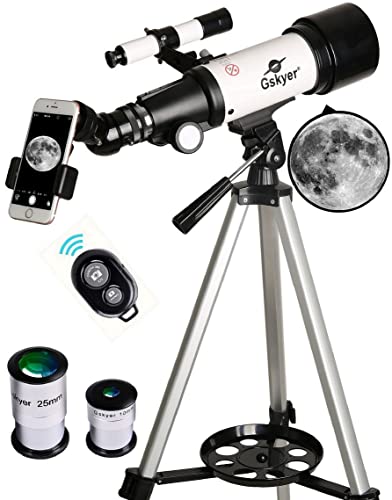
This telescope is a great choice for those who are interested in exploring the night sky. With a focal length of 400mm(f/5.7) and an aperture of 70mm, it is capable of providing clear and detailed images of celestial objects such as stars and the moon. The large aperture makes it an ideal option for amateur astronomers.
The fully coated optics glass lens with high transmission coatings enables the reduction of reflections and an increase in light transmission to the eyepiece. As a result, it produces brighter and more vibrant images. Additionally, the lens is designed to protect the observer's eyes, making it a safer choice for extended viewing sessions.
This telescope comes with two replaceable eyepieces and a 3x Barlow lens that can triple the magnifying power of each eyepiece. This feature allows for a range of magnification options, making it easier to observe objects at different distances. Furthermore, the 5×24 finder scope with mounting bracket and cross-hair lines can help locate objects easily, even for beginners.
The included wireless remote and smartphone adapter make it easy and convenient to explore the night sky and capture stunning celestial images. The wireless remote allows for easy adjustment of the telescope from a distance, while the smartphone adapter enables the user to take pictures of the objects they are viewing.
This telescope is designed with an adjustable aluminum alloy tripod that allows for many different viewing positions. The included carry bag makes it easy to set up and transport the telescope to different locations. Overall, this telescope is a powerful and versatile tool that is perfect for those who are interested in exploring the night sky.
9. Celestron – Astromaster 114eq Newtonian
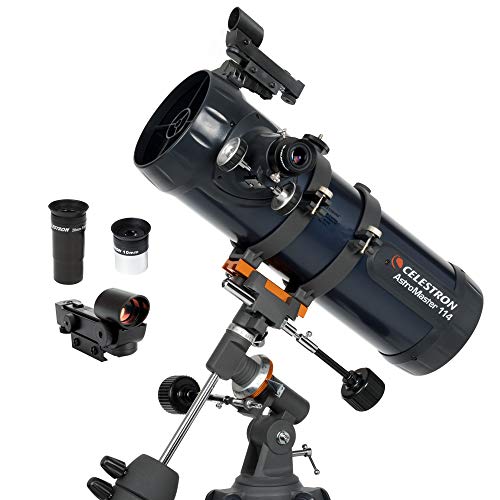
The Celestron AstroMaster 114EQ Newtonian telescope is a powerful and user-friendly reflector telescope designed for stargazing enthusiasts. Equipped with fully-coated glass optics, a full-height tripod, 2 eyepieces, and a StarPointer red dot finderscope, this telescope is the perfect tool for exploring the night sky.
Featuring a Newtonian reflector optical design and a 114mm aperture, the AstroMaster 114EQ can gather enough light to provide clear views of our Solar System and beyond. With this telescope, you can view Saturn's rings, Jupiter's Galilean moons, the Moon's craters, and more.
The Celestron AstroMaster 114EQ is easy to set up and use, making it a great telescope for both kids and adults to enjoy together. The manual German Equatorial mount allows for smooth and accurate pointing, while the quick and easy setup requires no tools.
In addition to the telescope, this package includes 2 eyepieces (20mm and 10mm), a full-height tripod, and a StarPointer red dot finderscope. As a bonus, you will receive a free download of one of the top-rated astronomy software programs.
When you purchase the Celestron AstroMaster 114EQ, you can buy with confidence knowing that you are getting a quality product from a leading telescope brand in California since 1960. Your purchase includes a 2-year US warranty and unlimited support from our team of US-based experts.
10. Astromaster 130eq Telescope: Beginner's Essential!
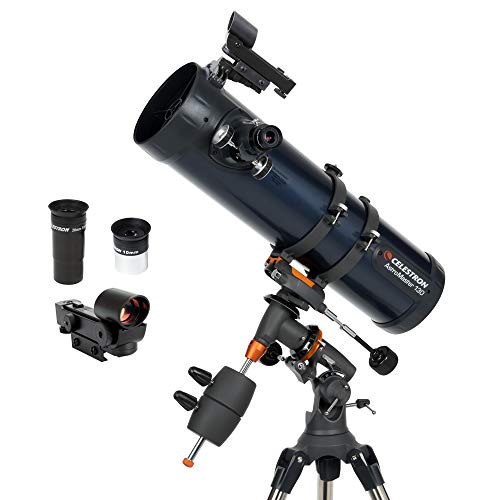
The Celestron AstroMaster 130EQ Newtonian reflector is an ideal telescope for those who are just starting out in astronomy. This powerful telescope is equipped with fully-coated glass optics, a full-height tripod, 2 eyepieces, and a StarPointer red dot finderscope, making it a great option for both kids and adults to use together.
With its Newtonian reflector optical design and large, 130mm aperture, the AstroMaster 130EQ is capable of gathering enough light to see our Solar System and beyond. From viewing Saturn’s rings and Jupiter’s Galilean moons to exploring the Moon's craters, this telescope offers a variety of sights to explore.
Setting up the AstroMaster 130EQ is quick and easy, with no tools required. It features a manual German Equatorial mount for smooth and accurate pointing, allowing you to easily position the telescope for optimal viewing.
In addition to the telescope itself, this package includes 2 eyepieces (20mm and 10mm), a full-height tripod, and a StarPointer red dot finderscope. You'll also receive a free download of one of the top-rated astronomy software programs to help you explore the night sky even further.
When you purchase from an Authorized Dealer on Amazon, you can buy with confidence knowing that you will receive a 2-year US warranty and unlimited support from Celestron's team of US-based experts. Celestron has been a leading telescope brand in California since 1960, and their commitment to quality and customer service is unmatched.
Best Home Telescope To See Planets FAQs
Can I see all the planets with a home telescope?
Yes, it is possible to see all the planets of our solar system with a home telescope. However, the size and quality of the telescope will determine how much detail can be seen. The most visible planets are Jupiter and Saturn due to their large size and distinctive features such as Jupiter's Great Red Spot and Saturn's rings. Mars, Venus, and Mercury are also visible, but they appear much smaller and less detailed than the gas giants. Uranus and Neptune can also be seen with a telescope, but they are much fainter and require a larger telescope and dark skies to observe. In addition to the planets, many deep-sky objects such as star clusters, nebulae, and galaxies can also be observed with a telescope. So, if you are interested in observing the planets and beyond, investing in a good quality telescope can be a worthwhile hobby.
Can I use a home telescope to see details on planets like Jupiter's Great Red Spot?
Yes, it is possible to use a home telescope to see details on planets like Jupiter's Great Red Spot. However, the level of detail that you will be able to see will depend on the quality of your telescope and the atmospheric conditions at the time of observation.
To see the Great Red Spot, you will need a telescope with at least a 4-inch aperture and a high magnification eyepiece. You may also want to consider using a color filter to enhance the contrast and visibility of the spot.
It is important to note that viewing planets through a telescope can be challenging, as they are constantly moving and atmospheric turbulence can affect the clarity of the image. It is recommended to practice and experiment with different settings and techniques to achieve the best possible view.
Overall, with the right equipment and conditions, it is definitely possible to observe and appreciate the details of planets like Jupiter using a home telescope.
How do I set up my home telescope for viewing planets?
To set up your home telescope for viewing planets, follow these steps:
1. Choose a clear, dark night for viewing. Planets are best viewed when the sky is clear and free of light pollution.
2. Set up your telescope in a stable location. Make sure the telescope is on a sturdy tripod or mount and is level.
3. Attach the appropriate eyepiece to the telescope. A high magnification eyepiece is best for viewing planets.
4. Point the telescope at the planet you want to view. Use a star chart or planetarium app to find the planet.
5. Adjust the focus of the telescope to get a clear image of the planet. You may need to adjust the focus several times.
6. Use a planetary filter if necessary. Some planets, such as Venus, are very bright and require a filter to reduce the glare.
7. Take your time and enjoy the view. Planets are fascinating to observe, and you may see interesting details like moons or cloud bands.
Remember to always follow proper safety precautions when viewing the sun or any other celestial object through a telescope. Happy stargazing!
How much does a good home telescope for viewing planets cost?
The cost of a good home telescope for viewing planets can vary greatly depending on the features and quality of the telescope. Generally, a decent telescope for planetary observation can range from around $200 to $1000 or more. However, it's important to note that the most expensive telescope doesn't always guarantee the best planetary viewing experience. Instead, factors such as aperture size, magnification, and the quality of the optics are more important. To get the most out of a telescope for planetary observation, it's also important to consider the viewing conditions, such as light pollution and atmospheric conditions. Ultimately, it's recommended to do some research on the different telescopes available within your budget range and read reviews from other users to make an informed decision.
What features should I look for in a home telescope for viewing planets?
When looking for a home telescope for viewing planets, there are several features you should consider. First, you want a telescope with a large aperture, which is the diameter of the main lens or mirror. The larger the aperture, the more light the telescope can gather, which means you'll be able to see fainter objects with greater detail. A minimum aperture of 70mm is recommended for planetary viewing.
Next, you want a telescope with a high magnification capability. Planets appear small in the sky, so you'll need to magnify them to see detail. Look for a telescope with a high focal length and a variety of eyepieces to achieve different magnifications.
Another important feature is a stable mount. Planetary viewing requires a steady image, and any wobbling or shaking can ruin the view. A sturdy mount, such as an equatorial or alt-azimuth mount, is crucial for steady viewing.
Lastly, consider the size and portability of your telescope. If you plan on taking your telescope to different locations, a smaller and more portable option may be better for you. However, larger telescopes with more advanced features may offer better viewing quality.
What is the best home telescope for viewing planets?
When it comes to viewing planets with a home telescope, there are a few factors to consider in order to find the best one for the job. The aperture size of the telescope is one of the most important considerations, as it determines the amount of light that can be gathered and therefore the level of detail that can be seen. A minimum aperture size of 70mm is recommended for planetary viewing.
Another important factor is the magnification power, which should be at least 50x per inch of aperture. A telescope with a motorized mount or tracking system can also be helpful for keeping planets in view as they move across the sky.
One popular option for planetary viewing is the Celestron NexStar 4SE, which has a 102mm aperture and a motorized mount. Another good choice is the Orion SkyQuest XT8, which has an 8-inch aperture and a solid Dobsonian mount.
Ultimately, the best home telescope for viewing planets will depend on your budget, needs, and preferences. It’s important to do your research and read reviews before making a purchase.
What is the largest planet I can see with a home telescope?
The largest planet that can be seen with a home telescope is Jupiter. Jupiter is the fifth planet from the sun and is the largest planet in our solar system. With its distinct coloration and visible cloud belts, Jupiter is a popular target for amateur astronomers. It is visible to the naked eye and can be easily located in the night sky. With a home telescope, the planet's four largest moons, known as the Galilean moons, can also be seen. These moons were first observed by Galileo Galilei in 1610 and are named after him. To get the best view of Jupiter, it is recommended to observe it when it is at its closest approach to Earth, which happens every 13 months. Overall, observing Jupiter through a home telescope can be a rewarding experience for amateur astronomers of all levels.
What magnification do I need to see planets with a home telescope?
To see planets with a home telescope, you'll need a magnification of at least 30x per inch of aperture (diameter of the telescope's main lens or mirror). For example, if you have a 6-inch telescope, you'll want a magnification of at least 180x. However, keep in mind that magnification alone does not determine how well you'll be able to see planets. Other factors such as atmospheric conditions and the quality of your telescope's optics will also play a role.
It's important to note that while high magnification can bring planets closer, it can also make the image dimmer and blurrier. It's often recommended to use the lowest magnification that still provides a clear image. Additionally, it's helpful to invest in a telescope with a sturdy mount and a good quality eyepiece to further enhance your viewing experience. Overall, a magnification of at least 30x per inch of aperture is a good starting point for observing planets with a home telescope.
What type of telescope is best for viewing planets from home?
The type of telescope that is best for viewing planets from home is a reflector telescope. Reflector telescopes use mirrors to gather and focus light, which makes them ideal for viewing bright objects like planets. They also tend to have larger apertures than other types of telescopes, which allows for more detailed views of planets. When choosing a reflector telescope for planetary viewing, look for one with a large aperture, a long focal length, and a solid mount that can support the weight of the telescope. It's also important to consider the viewing conditions in your area, as light pollution can affect the clarity of your views. Overall, a good quality reflector telescope can provide stunning views of planets like Jupiter, Saturn, and Mars from the comfort of your own backyard.
Where can I find reviews and recommendations for the best home telescopes for viewing planets?
There are several reliable sources where you can find reviews and recommendations for the best home telescopes for viewing planets. One of the most popular sources is astronomy magazines such as Sky & Telescope, Astronomy, and BBC Sky at Night. These magazines often feature product reviews and comparisons, as well as expert recommendations from seasoned astronomers.
Another great source is online forums and communities, such as Cloudy Nights and Astronomy Forum. Here, you can interact with fellow amateur astronomers, ask questions, and read reviews and recommendations from people who have hands-on experience with various telescopes.
Lastly, you can also check out online retailers such as Amazon and Optics Planet, where customers leave reviews and ratings for the products they have purchased. These reviews can provide valuable insights into the performance, ease of use, and overall quality of a particular telescope.
Overall, it's important to do your research and read multiple reviews from various sources before making a decision on which telescope to purchase.







